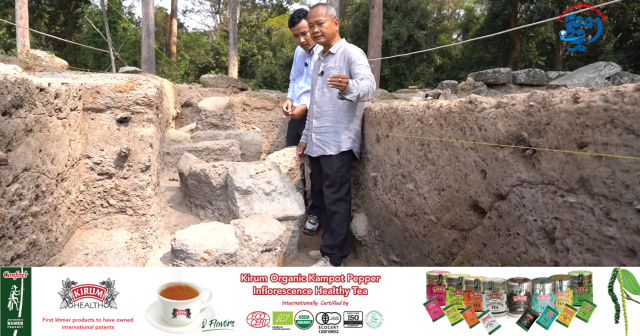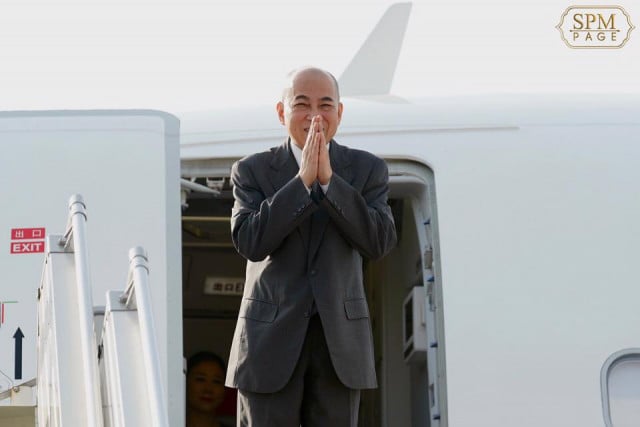Excavating the Bayon Temple’s Pond to Retrace its History

- By Sem Vanna
- March 31, 2024 11:30 AM
SIEM REAP — Archaeologists of the APSARA National Authority—the Cambodian government body that manages the Angkor Archeological Park in Siem Reap province—have been looking into reclaiming one of the Bayon’s ponds on the south side of the temple.
This is being done in order to improve the grounds’ appearance and water management at this late-12th/early-13th century temple in Angkor Park, as archaeologist Khieu Chan explained during an interview.
_1711730538.png)
Caption: Archaeologist Khieu Chan of the APSARA National Authority speaks during an interview with ThmeyThmey journalist Sem Vanna at the Bayon temple on Feb 7, 2024. Photo: Heng Ratanakvisal
Sem Vanna: After a month or so of working at this site, what conclusion can you make based on the study your team is conducting?
Khieu Chan: The intention behind this excavation is to retrace the history of this pond and the reasons behind it being filled. We have studied the structure through previous documentation and now we need to get our hands on the site. Hopefully, the excavation will provide us with some details as to how the pond ended up filled with soil. Meanwhile, we also take the opportunity to study the relation between the pond and the nearby outer laterite wall to see which one is older. This is believed to have been built during the middle period also known as the post-Bayon period [from the early 15th century to the start of the French Protectorate in 1863].
_1711730673.png)
As shown by our excavation, the soil that filled the pond also contained tiny broken pieces of construction materials such as clay tiles, pieces of sandstone and laterite stones as well as pieces of local and Chinese potteries namely celadon. It is thought that the soil filling this pond was brought from a construction site elsewhere.
_1711730703.png)
It is important to know that, during the middle period, the region of Angkor was no longer the administrative center of the kingdom, and Buddhism became more widespread. Many structures were built or converted [to include] various images of Buddha such as those at the back of the Baphuon temple, on top of the Bakheng temple—although it was removed— as well as many other pagodas or vihara foundations found around the area of the walled city of Angkor Thom.
_1711730984.png)
People with wealth would commission bronze statues of the Buddha to be cast for pagodas. Looking under the ground, this could possibly be a mold used to cast such an object.
_1711730729.png)
The bottom clay layer below the layer of soil put in subsequently is believed to have been laid during the construction of the Bayon temple itself.
According to research, the walled city of Angkor Thom, at the center of which is the Bayon temple, went through seven major stages of development. On this exact spot, we can identify two major stages: one during the Bayon period and another one during the post-Bayon period.
_1711730859.png)
Immediately above the clay layer is a layer of sand followed by a layer of stones forming the tiers of the pond. Based on information from the Japanese Government Team for Safeguarding Angkor (JSA), the thickness of the filled soil is about 4-meter deep with 13 tiers. This type of soil-layer arrangement can also be seen at the Western Mebon temple where the use of water is very prominent and complex.
_1711731016.png)
Currently, our excavation work is obstructed due to excessive water seeping from underneath. We need to be careful as water can definitely affect the sand layer above if we try to disassembly the stones. Documentation is required before things can proceed further.
_1711730833.png)
Sem Vanna: Will the multiple tiers of the pond be restored?
Khieu Chan: I cannot say for sure whether the stone tiers of the pond will be restored. What I can say is that the soil in the pond itself will be removed. Then, a water system will be connected from the east to fill this pond when needed.
_1711730907.png)
Sem Vanna: How do you manage restoring such structures while keeping them the way they were?
Khieu Chan: Some structures should be restored to their original state, but others should be left as they now are after centuries.
For example, when looking at the Baphuon temple, we can see both the depictions of Hinduism and Buddhism being preserved and restored even though the structures existed during two distinct periods.
Another example would be the transformation of the Phnom Bakheng temple. Originally a Hindu temple, the top level of the Bakheng was transformed from a group of towers into a large statue of Buddha during the middle period. Later on, when French archaeologists came to the site during the Protectorate period, they disassembled the statue of the Buddha, which was in ruins, and paved the way for the temple to look like a Hindu monument again.
Experts from the International Coordinating Committee of Angkor—which includes Cambodian and international experts who review all restoration projects—frequently encourage the idea of meticulously studying the changes and the transformations of each monument to show as much as possible the historical stages from one period to the other.
Originally conducted in Khmer for ThmeyThmey Digital Media, this interview was translated by Luy Sireyreaksa for Cambodianess.
To watch the original interview in Khmer, click here.
Related articles:
Phnom Bakheng: an Angkor Period Heaven on Earth
Baphuon: Why does this Hindu Temple Have an Image of Buddha?
Angkor Thom: the Khmer Empire’s Enclosed and Complex 12th Century City















